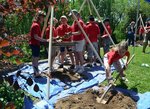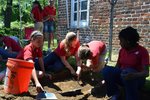Clear, 89°
Wind: mph,


Jean-Baptiste-Donatien de Vimeur isn’t very well known to Americans by his given name. Few people know that he fought the British alongside General George Washington to help secure freedom for Americans in the American Revolution.
During the revolt, 5,000 troops and 4,000 cattle led by de Vimeur - better known as Count de Rochambeau - camped from 8:00pm to 2:00am on September 16-17, 1781, at Scott’s Plantation, also referred to as Belvoir, on General’s Highway in Crownsville. The 17th-century property, which once was owned by the aunt of Francis Scott Key, is now owned by Rockbridge Academy, and portions of the grounds were recently dug up by an archaeology team from the State Highway Administration.
Dr. Julie Schablitsky, the chief archaeologist for SHA, said the five-week dig would not only prove that Rochambeau’s troops camped on the 125-acre property and possibly reveal the location of a slave quarters inhabited by servants to the Scott family, but also help the administration better understand the history of development along the highway.
“This will help with future planning and a better understanding of how we manage our resources along transportation routes,” Schablitsky said.
The $300,000-plus partnership between the SHA and Anne Arundel County yielded no proof of Rochambeau’s troops’ encampment at the plantation — the count had accompanied Washington to Mount Vernon a week earlier — but one reason could have been ground erosion and the brevity of the team’s visit. Still, Schablitsky believes, there must be something on the property that proves the location of that camp.
“When they camped, it was the largest town in Maryland at the time,” she said. “Five thousand people are a lot of people. Even though it would be a subtle archaeological signature … they still would’ve left something (such as buttons or coins) that would’ve been a calling card.”
The project began with a pre-investigation in April, which included the use of metal detectors, ground-penetrating radar equipment and, according to Schablitsky, “good, old-fashioned archaeology, which is digging a hole in the ground and hoping we find something.”
The final day of the dig might have yielded the project’s most impressive discovery and it had nothing to do with Rochambeau’s camp. Pete Regan, an archaeologist with New Jersey-based URS Archaeology, excavated a portion of a stone building that he and Schablitsky believe might be the discovery they had hoped for — the Scotts’ slave quarters.
“Pete kept on digging, digging, digging, and sure enough, he has come up with what could be the foundation (of the slave quarters),” she revealed. “You find the best stuff on the last day. This is the thing we wanted to find — this is even better than a Rochambeau encampment.”
Schablitsky believes the rich history of slavery in the U.S. provides a deeper story than Rochambeau’s encampment. Between 25 and 30 slaves were likely owned by the Scott family, but little to nothing is known about them as individuals. The discovery of the slave quarters would amount to a monumental and historic find, she said.
“That’s always the most important spot, I think, to look for on an archaeological site, because we have so few records about these people,” she stated.
Patience is a virtue for archaeologists. People like Regan and Schablitsky laboriously scour sites using tools such as toothbrushes, hoping to clear away just enough earth to give them some inkling of hope — or confirmation — that the objects they seek do exist. Regan is fine with the meticulousness of his chosen profession because the rewards, he said, are worth the work.
“It takes a great deal of patience, but it’s also tempered by the fact that you know the payoff of it is good data collection, and good data collection is what you’re going to be able to use to tell your story,” he explained. “If you hack through a little too quickly, you can potentially lose a little bit of the data that could fill in the blanks.”
During the project, Rockbridge students and local politicians visited the site and were treated to a few lessons on archaeology. Senator Ed Reilly and Maryland Speaker of the House Michael Busch rolled up their sleeves and saw firsthand some of the artifacts the archaeologists discovered at the plantation. Reilly said these types of projects are highly significant to local and American history.
"In Maryland, our kids can learn about the importance of conservation in nature — our wetlands, the bay, our wildlife,” said Reilly. “But right here, we can teach them about the importance of conserving our history."
Among the artifacts found at the plantation were pig mandibles, cow teeth, porcelain doll heads and candlestick holders, old keys, wine bottles and plenty of clothing buttons. Those types of findings seem cool to archaeologists and Rockbridge students. Fifth-grader Justice Powell enjoyed himself during the students’ visit to the plantation and gave the Crownsville site a rousing endorsement.
“It’s better than Williamsburg, even,” he said.
Comments
No comments on this item Please log in to comment by clicking here